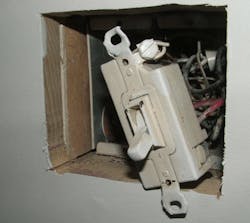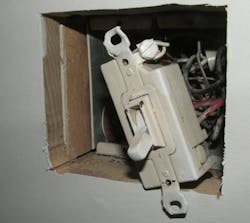How well do you know the Code? Think you can spot violations the original installer either ignored or couldn't identify? Here's your chance to moonlight as an electrical inspector and second-guess someone else's work from the safety of your living room or office. It's your turn to identify the violation.
Hint: Problem with your depth perception?
Find the Answer
Even extra-long 6/32 machine screws won't make this Code violation disappear.
According to 314.20, boxes, plaster rings, extension rings, or listed extenders using a flush-type cover or faceplate installed "in walls and ceilings constructed of wood or other combustible surface material, shall be flush with the finished surface or project there from." The combustible wooden wall surface shown here could easily ignite if exposed to arcs or sparks from a short-circuit or ground-fault event occurring in this box. It's important to note that Section 314.20 does permit the front edge of these enclosures to be set back from the finished surface a maximum of ¼ in. only where the wall or ceiling surface is made of a non-combustible material.
In addition, 404.10(B) requires flush-type snap switches to be installed so that the extension plaster ears are seated against the surface, when mounted in boxes that are set back of the finished surface as permitted in 314.20. Flush-type snap switches shall be installed so that the mounting yoke or strap of the switch is seated against the box when mounted in boxes that are flush with the finished surface or project from it. Neither the box nor the switches were installed correctly in this installation.
> Try Another Quiz
About the Author

Russ LeBlanc
Owner
Russ started in the electrical trade as an apprentice in 1985. He worked his way up to become a Journeyman Electrician and then eventually became a Master Electrician and Licensed Construction Supervisor. In 1999 Russ become an Electrical Instructor for The Peterson School of Engineering in Massachusetts where he developed his passion for teaching, and quickly became Department Head of Electrical Instruction. Russ has taught thousands of apprentices, electricians, engineers, inspectors, and other electrical professionals during his career as an instructor. He continues to provide electrical professionals with Electrical Code seminars, Arc-Flash Awareness training seminars and educational material through his LeBlanc Consulting Services in North Reading, MA whose specialty is educating electricians. He has been an active member of the NFPA Electrical Section and has authored hundreds of National Electrical Code proposals and comments which have become Code rules to improve the safety for the electrical industry. Russ is also an IAEI certified Electrical Inspector.
Please visit www.russleblanc.net for more information.

